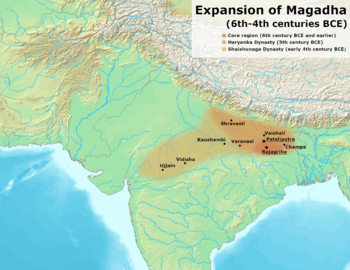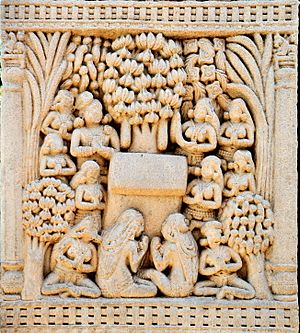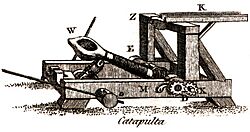Haryanka dynasty facts for kids
Quick facts for kids
Haryanka Dynasty
|
|||||||||||||
|---|---|---|---|---|---|---|---|---|---|---|---|---|---|
| 544 BCE–413 BCE | |||||||||||||

The approximate extent of the Haryanka dynasty between the 6th and 5th century BCE.
|
|||||||||||||
| Capital | Rajagriha later Pataliputra |
||||||||||||
| Common languages | Sanskrit Magadhi Prakrit Other Prakrits |
||||||||||||
| Religion | Hinduism Jainism Buddhism |
||||||||||||
| Government | Monarchy | ||||||||||||
| King | |||||||||||||
|
• 544-492 BCE
|
Bimbisara | ||||||||||||
|
• 492-460 BCE
|
Ajatashatru | ||||||||||||
|
• 460-444 BCE
|
Udayin | ||||||||||||
| History | |||||||||||||
|
• Established
|
544 BCE | ||||||||||||
|
• Disestablished
|
413 BCE | ||||||||||||
|
|||||||||||||
| Today part of | India | ||||||||||||
The Haryanka dynasty was the first major ruling family of Magadha. Magadha was an important empire in ancient India. At first, their capital city was Rajagriha. Later, during the rule of Udayin, the capital moved to Pataliputra. This city is near modern-day Patna in India. Many historians believe Bimbisara started this dynasty.
According to old Buddhist writings like the Mahavamsa, Bimbisara became king when he was just fifteen. His father, Bhattiya, appointed him. The Shishunaga dynasty took over after the Haryanka rulers.
Contents
How the Haryanka Dynasty Ruled
Ancient texts tell us about the Haryanka dynasty's government. They had gramakas, who were like village leaders. These leaders managed village meetings. There were also mahamatras, who were high-ranking officials. These officials handled many jobs. They made decisions, settled disagreements, and led the army.
This time period also saw the Achaemenid conquest of the Indus Valley. This happened around 517/516 BCE. It was during the rule of Darius I.
Key Rulers of Haryanka Dynasty
King Bimbisara: The Founder
Bimbisara ruled from 544 to 492 BCE. Old texts like Mahavagga describe how large his kingdom was. He had many trusted advisors. One was Jīvaka, a famous doctor. Bimbisara was also known by the title Seniya.
Both Jain and Buddhist religious texts talk about Bimbisara. Jain texts say he followed Mahavira. Buddhist texts, like Sutta Nipata, say he and his wife, Khema, followed Buddha. The Buddhist texts also mention that Bimbisara sent Jīvaka to help Buddha's followers. Bimbisara also married Chellana and Kosala Devi. Kosala Devi was the sister of King Pasenadi.
King Ajatashatru: Expanding the Kingdom
Ajatashatru ruled from 493 to 462 BCE. He married Princess Vajira, who was a princess from Kosala.
Some historical records suggest that Ajatashatru took over the throne from his father, Bimbisara. During Ajatashatru's rule, the Haryanka dynasty became very powerful. Its kingdom grew to its largest size. Ajatashatru lived at the same time as Mahavira (599–527 BCE) and Gautama Buddha (563–483 BCE). He fought a major war against the Vajjika League, who were led by the Lichhavis. Ajatashatru won this war and conquered them.
King Udayin: Moving the Capital
Udayin, also called Udayabhadra, is mentioned in Buddhist and Jain texts. They say he was the next ruler after Ajatashatru. However, other ancient texts, called the Puranas, list him as the fourth king. Udayin was important for moving the capital city to Pataliputra.
Later Haryanka Rulers
The Puranas mention Nandivardhana and Mahanandin as later rulers after Udayin. Buddhist traditions, however, list Anuruddha, Munda, and Nagadarshaka as the kings who followed Udayin.
List of Haryanka Rulers
- Bimbisara (544–492 BCE)
- Ajatashatru (492–460 BCE)
- Udayin (460–444 BCE)
- Anuruddha (444–440 BCE)
- Munda (440–437 BCE)
- Darshaka (437 BCE)
- Nāgadāsaka (437–413 BCE)
Decline of the Dynasty
The Haryanka dynasty was eventually overthrown. Their own minister, named Shishunaga, took control. This led to the start of the Shishunaga dynasty.
See also
- Magadha-Vajji war
- Pradyota dynasty
- Avanti-Magadhan Wars



